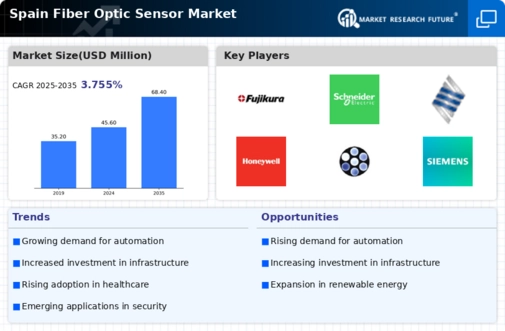Advancements in Sensing Technology
Technological advancements in sensing capabilities are significantly influencing the fiber optic-sensor market in Spain. Innovations such as distributed sensing and enhanced sensitivity are expanding the applications of fiber optic sensors across various sectors, including energy, healthcare, and transportation. For instance, the energy sector is increasingly utilizing fiber optic sensors for monitoring pipeline integrity and detecting leaks, which can lead to substantial cost savings. The market is projected to grow at a CAGR of around 12% over the next five years, driven by these technological improvements. As industries seek more reliable and efficient monitoring solutions, the fiber optic-sensor market is poised for substantial growth.
Government Initiatives and Funding
Government initiatives aimed at promoting technological innovation are playing a pivotal role in the fiber optic-sensor market in Spain. Various funding programs and grants are being introduced to support research and development in sensor technologies. The Spanish government has earmarked approximately €500 million for technology-driven projects, which includes the development of fiber optic sensors. This financial backing is likely to stimulate innovation and encourage collaboration between public and private sectors, thereby enhancing the market landscape. As a result, the fiber optic-sensor market is expected to benefit from increased investment and a more favorable regulatory environment.
Growing Focus on Safety and Security
The increasing focus on safety and security across various sectors is driving the fiber optic-sensor market in Spain. Industries such as oil and gas, transportation, and construction are prioritizing the implementation of advanced monitoring systems to mitigate risks and enhance operational safety. Fiber optic sensors provide critical data for detecting hazardous conditions, thereby enabling timely interventions. The market is witnessing a shift towards integrating these sensors into safety protocols, which is likely to result in a market growth of approximately 10% over the next few years. This trend underscores the importance of fiber optic sensors in ensuring compliance with safety regulations and enhancing overall operational efficiency.
Expansion of Renewable Energy Projects
The expansion of renewable energy projects in Spain is significantly impacting the fiber optic-sensor market. As the country aims to increase its renewable energy capacity, the need for efficient monitoring systems becomes paramount. Fiber optic sensors are being utilized for real-time monitoring of wind turbines and solar panels, ensuring optimal performance and maintenance. The Spanish government has set ambitious targets to achieve 74% of its electricity generation from renewable sources by 2030, which is likely to drive the demand for fiber optic sensors in this sector. This growth potential indicates a promising future for the fiber optic-sensor market as it aligns with national energy goals.
Rising Demand for Smart Infrastructure
The fiber optic-sensor market in Spain is experiencing a surge in demand due to the increasing emphasis on smart infrastructure. As urban areas evolve, the integration of advanced technologies in construction and maintenance becomes essential. Fiber optic sensors offer real-time monitoring capabilities, which are crucial for ensuring the safety and efficiency of infrastructure projects. The Spanish government has allocated approximately €1 billion for smart city initiatives, which is likely to enhance the adoption of fiber optic sensors in various applications, including structural health monitoring and environmental sensing. This trend indicates a robust growth trajectory for the fiber optic-sensor market, as stakeholders seek innovative solutions to meet the demands of modern urbanization.



















Leave a Comment